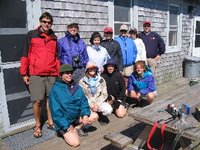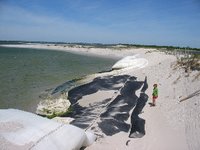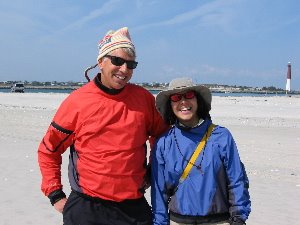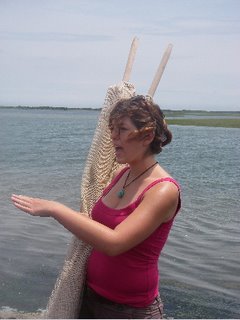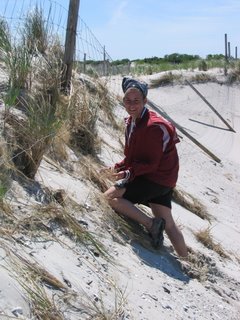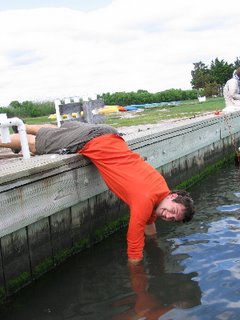
This past weekend was an especially special one for me on Sedge Island. This weekend Sedge Island welcomed a group of teachers from Cranford High School, where I teach. With us were Interns Alyssa and Bret and Damian Holynskyj who works for NJ Fish and Wildlife in Trenton.

When we got to Sedge on Friday evening we promptly got in the kayaks and took a tour through the mosquito ditches and got to see the peregrine falcons chasing a great blue heron away from their nest. We dug for some clams and pulled back into the sedge landing with the setting sun.

The next day we got out early and headed through the marsh to the USACE Dike at the Barnegat Inlet. There has been no formal research on the impact of the USACE dyke on the water quality in the sedges right behind the dike, so we brought out our water quality equipment and tested the temperature, nitrates, phosphates, pH and most importantly dissolved oxygen. Last summer during warmer weather the water quality of that area seemed to degrade quickly and this year we will be testing the water at the sedge island dock and the back bay at the dike for comparison.

Last week (see Somorset County Parks) we headed to the dike to look for horseshoe crab eggs that should have been laid on the previous full moon and only found dead females picked out by the gulls. This weekend Bret said he had seen the horseshoe crabs in the rocks that make up part of the dyke. We poked in the rock wall and there must have been a hundred horseshoe crabs stuck in the rocks. We all climbed down and helped to free the ancient creatures and rescued many. There was one crab that I focused on for about 10 minutes, but despite all my effort, I could not free the large female. It was then that I realized so many of these crabs were going to die despite our best efforts. In years past thousands of horseshoe crabs could be seen gathering on the beaches to lay their eggs, and now the beaches have been replaced by the rocks and the horseshoe crabs have not adapted well to the changes. Something tells me that because of this weekend Sedge Island will get more involved with the horseshoe crab effort.
With humans encroaching on so much wildlife in NJ it did not come as a surprise to see an American Oystercatcher nesting about 10 feet from many beach buggies. Someone had built a rock wall around the nest, and while that may seem like a nice gesture for the birds it actually draws more attention to the nest. When we left the beach a gentleman was pointing out the nest to a woman and the birds were off the nest. Tom Virzi who is doing critical research on these birds told us the eggs would not hatch out because the birds have been scared off the nest too many times for the eggs to develop properly.
Back at the Sedge House, many took a well deserved snooze after our 7 mile paddle, and Rich and Carmine joined Brett and Tony in putting out the Marine Conservation Buoys. Linda and Kerith later showed us how the pro’s clam, and Alyssa grilled up a delicious dinner. The night concluded with discussions of an early morning paddle and reflections on the day.

Sunday Morning the group pitched in yet again on the island and helped pick sea stars out from our aquaculture bags. We collected over one hundred of the pesky tube footed creatures and Daphne even collected a few to take home with her! We went seining and caught a whole school of baby blue fish barely an inch long. We all worked together and were able to corral them in to the net. We collected a few specimens for our look tank and released the rest.

It was great getting to know my colleagues in a different light, and I hope this will become an annual trip for Cranford!
***To comment on this post, click on the "Comments" link below and choose "anonymous" as your identity (easiest way to post) don’t forget to sign your name on your comment***






